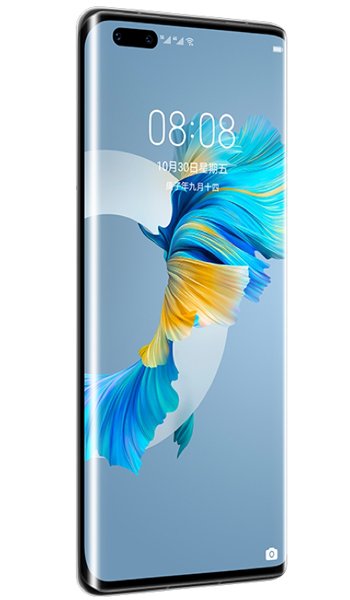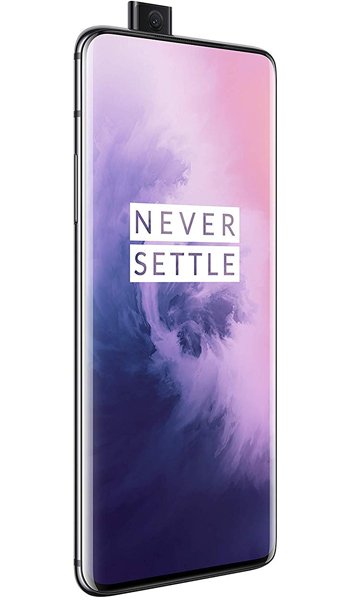Huawei Mate 40 Pro+ vs OnePlus 7 Pro Comparison and Differences
Smartphone 1

Huawei Mate 40 Pro+
Smartphone 2

OnePlus 7 Pro
Smartphone 3
Huawei Mate 40 Pro+ or OnePlus 7 Pro Specs Comparison
or
 Common specs
Common specs
| Brand and model | Huawei Mate 40 Pro+ | OnePlus 7 Pro | |
| Rating | (+) | (+) | |
| Release date | 2020, October 22 | 2019, May | |
| Dimensions (HxWxD) | 162.9 x 75.5 x 8.8 mm | 6.41 x 6.41 x 2.97 in | 162.6 x 75.9 x 8.8 mm | 6.4 x 6.4 x 2.99 in | |
| Weight | 230 g | 8.11 oz | 206 g | 7.27 oz | |
| Body Build | Glass front, ceramic back, aluminum frame | Front/back glass, aluminum frame | |
| Case | buy from Amazon | buy from Amazon | |
| Colors | Ceramic White, Ceramic Black | Mirror Grey, Almond, Nebula Blue | |
| Battery | 4400 mAh, Li-Po, non-removable | 4000 mAh, Non-removable Li-Po | |
| Approximate price | 1400 EUR | 700 EUR | |
| Check price | from Amazon | from Amazon |
 Screen
Screen
| Technology | OLED | Fluid AMOLED | |
| Touchscreen | capacitive touchscreen | capacitive touchscreen | |
| Display colors | 16M | 16M | |
| Screen size | 6.76" in | 6.67" in | |
| Screen area | 115.7 cm2 | 108.8 cm2 | |
| Screen format | 18.5:9 (height:width) | 19.5:9 (height:width) | |
| Screen to body ratio | 94.1% | 88.1% | |
| Screen resolution | 1344 x 2772 px | 1440 x 3120 px | |
| Screen PPI /points per inch/ | 456 PPI | 516 PPI | |
| Screen protection | Corning Gorilla Glass | ||
| Other specs | - HDR10 -90Hz |
- DCI-P3 -HDR10+ -90Hz |
|
| Screen protector | buy from Amazon | buy from Amazon |
 Camera and Video
Camera and Video
| Rear camera, main | 50 MP, Five | 48 MP, Triple | |
| Camera specs | -50 MP, f/1.9, 23mm (wide), 1/1.28'', 1.22µm, omnidirectional PDAF, Laser AF, OIS -12 MP, f/2.4, (telephoto), PDAF, OIS, 3x optical zoom -8 MP, f/4.4, 240mm (periscope telephoto), PDAF, OIS, 10x optical zoom -20 MP, f/2.4, 14mm (ultrawide), PDAF -TOF 3D, (depth) |
-48 MP, f/1.6, (wide), 1/2'', 0.8µm, Laser/PDAF, OIS -16 MP, f/2.2, 13mm (ultrawide) -8 MP, f/2.4, 78mm (telephoto), 3x zoom, Laser/PDAF, OIS |
|
| Functions | Leica optics, LED flash, panorama, HDR | Dual-LED dual-tone flash, panorama, HDR | |
| Video | 4K@30/60fps, 1080p@30/60/120/240/480fps, 720p@960fps, 720p@3840fps, HDR, gyro-EIS | 2160p@30/60fps, 1080p@30/60/240fps, 720p@480fps, Auto HDR, gyro-EIS | |
| DxOMark Main Score | 139 | 114 | |
| DxOMark Photo | 144 | 122 | |
| DxOMark Video | 115 | 98 | |
| Front camera, selfie | 13 MP, Dual | 16 MP, Single | |
| Specifications | 13 MP, f/2.4, 18mm (ultrawide) TOF 3D, (depth/biometrics sensor) |
Motorized pop-up 16 MP, f/2.0, 25mm (wide), 1/3.0'', 1.0µm | |
| Functions | HDR, panorama | Auto-HDR | |
| Video | 4K@30/60fps, 1080p@30/60/240fps | 1080p@30fps, gyro-EIS | |
| DxOMark Selfie Score | 86 | ||
| DxOMark Photo | 90 | ||
| DxOMark Video | 81 |
 Performance
Performance
| Operating system - OS | Android 10, EMUI 11, no Google Play Services | Android 9.0 (Pie); OxygenOS 9 | |
| Chipset | - HiSilicon Kirin 9000 5G (5 nm) | - Qualcomm SM8150 Snapdragon 855 (7 nm) | |
| CPU | - Octa-core (1x3.13 GHz Cortex-A77 & 3x2.54 GHz Cortex-A77 & 4x2.05 GHz Cortex-A55) | - Octa-core (1x2.84 GHz Kryo 485 & 3x2.42 GHz Kryo 485 & 4x1.80 GHz Kryo 485) | |
| GPU | Mali-G78 MP24 | Adreno 640 | |
| External memory | NM (Nano Memory), up to 256GB (uses shared SIM slot) | No | |
| Internal memory | 256GB 12GB RAM | 256 GB, 8/12 GB RAM 128 GB, 6 GB RAM |
 Benchmark
Benchmark
| Antutu 8 Total | 661059 | 473991 | |
| Antutu 7 Total | |||
| GeekBench 6 Single Core | 1191 | 942 | |
| GeekBench 6 Multi Core | 3479 | 2605 | |
| GeekBench 6 OpenCL | 6640 | 2443 | |
| GeekBench 6 Vulkan | 6636 | 2196 | |
| GeekBench 5 Single Core | 980 | 729 | |
| GeekBench 5 Multi-Core | 3595 | 2678 | |
| GeekBench 4 Single Core | 3428 | ||
| GeekBench 4 Multi-Core | 10717 | ||
| GeekBench 4 RenderScript | 7260 |
 Communication and Connectivity
Communication and Connectivity
| SIM card | Single SIM (Nano-SIM)Hybrid Dual SIM (Nano-SIM, dual stand-by) | Dual SIM (Nano-SIM, dual stand-by) | |
| Network | GSM / HSPA / LTE / 5G | GSM / CDMA / HSPA / LTE | |
| Bands | -2G - GSM 850 / 900 / 1800 / 1900 - SIM 1 & SIM 2 (dual-SIM model only) -3G - HSDPA 800 / 850 / 900 / 1700(AWS) / 1900 / 2100 -4G - 1, 2, 3, 4, 5, 6, 7, 8, 9, 12, 17, 18, 19, 20, 26, 34, 38, 39, 40, 41 -5G - 1, 3, 28, 38, 40, 41, 77, 78, 79, 80, 84 SA/NSA/Sub6 |
-2G - GSM 850 / 900 / 1800 / 1900 - SIM 1 & SIM 2 CDMA 800 / 1900 & TD-SCDMA -3G - HSDPA 800 / 850 / 900 / 1700(AWS) / 1800 / 1900 / 2100 -4G - LTE band 1(2100), 2(1900), 3(1800), 4(1700/2100), 5(850), 7(2600), 8(900), 12(700), 13(700), 17(700), 18(800), 19(800), 20(800), 25(1900), 26(850), 28(700), 29(700), 32(1500), 34(2000), 38(2600), 39(1900), 40(2300), 41(2500), 66(1700/2100) - Global LTE band 1(2100), 2(1900), 3(1800), 4(1700/2100), 5(850), 7(2600), 8(900), 12(700), 13(700), 17(700), 18(800), 19(800), 20(800), 25(1900), 26(850), 28(700), 29(700), 32(1500), 34(2000), 38(2600), 39(1900), 41(2500), 46, 48, 66(1700/2100), 71(600) - North America |
|
| Speed | HSPA 42.2/5.76 Mbps, LTE-A, 5G | HSPA 42.2/5.76 Mbps, LTE-A (5CA) Cat18 1200/150 Mbps | |
| GPRS | Yes | Yes | |
| Edge | Yes | Yes | |
| Wi-Fi | Wi-Fi 802.11 a/b/g/n/ac/6, dual-band, Wi-Fi Direct, hotspot | Wi-Fi 802.11 a/b/g/n/ac, dual-band, WiFi Direct, DLNA, hotspot | |
| GPS | Yes, with dual-band A-GPS, GLONASS, BDS, GALILEO, QZSS, NavIC | Yes, with dual-band A-GPS, GLONASS, BDS, GALILEO, SBAS | |
| NFC | Yes | Yes | |
| USB | USB Type-C 3.1, USB On-The-Go | 3.1, Type-C 1.0 reversible connector, USB On-The-Go | |
| Bluetooth | 5.2, A2DP, LE | 5.0, A2DP, LE, aptX HD |
 Music and Audio
Music and Audio
| Radio | No | No | |
| Headphone jack | No | No | |
| Others | - 32-bit/384kHz audio | - Active noise cancellation with dedicated mic -Dolby Atmos sound |
 Other features
Other features
| Sensors | - Face ID, fingerprint (under display, optical), accelerometer, gyro, proximity, barometer, compass, color temperature sensor , Infrared port | - Fingerprint (under display), accelerometer, gyro, proximity, compass | |
| Other extras |
- Fast charging 66W -Fast wireless charging 50W -Reverse wireless charging 5W - IP68 dust/water resistant |
- Fast battery charging 30W (Warp Charge) |
Reviews and Opinions on Huawei Mate 40 Pro+ and OnePlus 7 Pro
If you had to recommend one of these phones to a friend, which one would it be and why? Share your arguments using the Add Opinion button!
